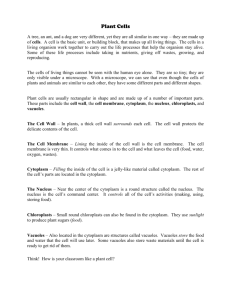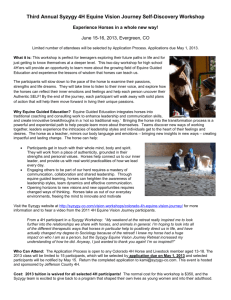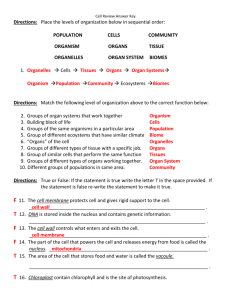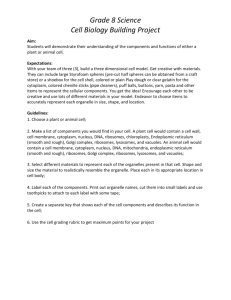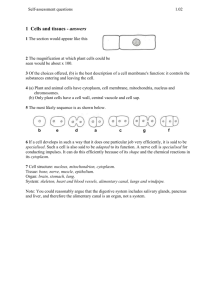Load PDF - Protistology
advertisement
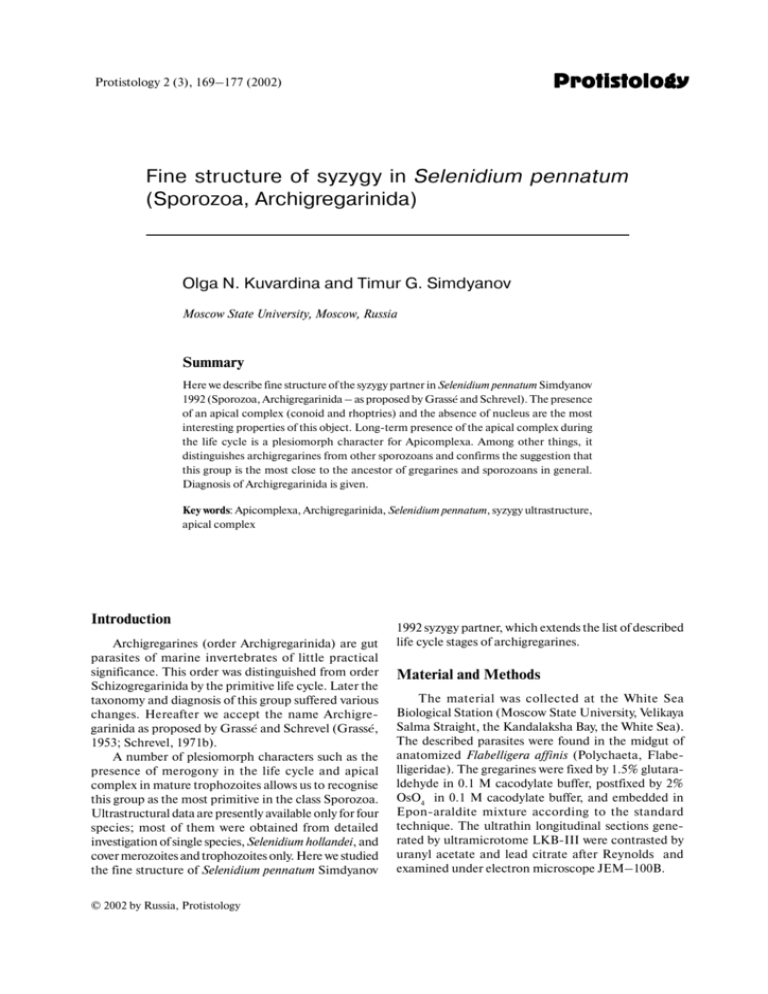
Protistology Protistology 2 (3), 169–177 (2002) Fine structure of syzygy in Selenidium pennatum (Sporozoa, Archigregarinida) Olga N. Kuvardina and Timur G. Simdyanov Moscow State University, Moscow, Russia Summary Here we describe fine structure of the syzygy partner in Selenidium pennatum Simdyanov 1992 (Sporozoa, Archigregarinida – as proposed by Grassé and Schrevel). The presence of an apical complex (conoid and rhoptries) and the absence of nucleus are the most interesting properties of this object. Longterm presence of the apical complex during the life cycle is a plesiomorph character for Apicomplexa. Among other things, it distinguishes archigregarines from other sporozoans and confirms the suggestion that this group is the most close to the ancestor of gregarines and sporozoans in general. Diagnosis of Archigregarinida is given. Key words: Apicomplexa, Archigregarinida, Selenidium pennatum, syzygy ultrastructure, apical complex Introduction Archigregarines (order Archigregarinida) are gut parasites of marine invertebrates of little practical significance. This order was distinguished from order Schizogregarinida by the primitive life cycle. Later the taxonomy and diagnosis of this group suffered various changes. Hereafter we accept the name Archigre garinida as proposed by Grassé and Schrevel (Grassé, 1953; Schrevel, 1971b). A number of plesiomorph characters such as the presence of merogony in the life cycle and apical complex in mature trophozoites allows us to recognise this group as the most primitive in the class Sporozoa. Ultrastructural data are presently available only for four species; most of them were obtained from detailed investigation of single species, Selenidium hollandei, and cover merozoites and trophozoites only. Here we studied the fine structure of Selenidium pennatum Simdyanov © 2002 by Russia, Protistology 1992 syzygy partner, which extends the list of described life cycle stages of archigregarines. Material and Methods The material was collected at the White Sea Biological Station (Moscow State University, Velikaya Salma Straight, the Kandalaksha Bay, the White Sea). The described parasites were found in the midgut of anatomized Flabelligera affinis (Polychaeta, Flabe lligeridae). The gregarines were fixed by 1.5% glutara ldehyde in 0.1 M cacodylate buffer, postfixed by 2% OsO4 in 0.1 M cacodylate buffer, and embedded in Eponaraldite mixture according to the standard technique. The ultrathin longitudinal sections gene rated by ultramicrotome LKBIII were contrasted by uranyl acetate and lead citrate after Reynolds and examined under electron microscope JEM–100B. 170 · Olga N. Kuvardina and Timur G. Simdyanov Fig. 1. Selenidium pennatum (stained by Karacci’s haemathoxylin; from: Simdyanov, 1992). A trophozoite (gamont); B – syzygy. Scale bar: 100 µm. Results Immobile caudal (tailtotail) syzygies are 210–230 µm long and 30–33 µm wide (Fig. 1, B). The partners (gametocytes) acquire the shape of a drop. In contrast to the trophozoites (Fig. 1, A), the nucleus is unde tectable. The association of the partners is unstable since even a mild influence (dehydration of the fixed sample) disjoins them. Because of that, longitudinal sections of a single partner rather than the whole syzygy were studied under electron microscope. The structural properties revealed by examination of the ultrathin sections of S. pennatum syzygy partner are discussed in this paper. GENERAL STRUCTURE OF SYZYGIES (FIGS 2, 3) The gametocyte body is covered by a trimemb rane pellicle up to 25 nm thick typical for sporo zoans. Glycocalyx is unmanifest. Longitudinal microtubules 20–25 nm wide underlie the pellicle (Figs 2, B, C) . The micropores, found in the tro phozoites of S. pennatum (Simdyanov, 1992) have not been observed. The cytoplasm has heterogeneous grain or fibrillar content. The boundary between ecto and endoplasm is not pronounced. The bulk of mitochondria with tubular cristae is localised in the peripheral cytoplasm under the layer of microtubules (Fig. 2, C). The mitochondria are round or slightly elliptical and reach 1–1.5 µm in diameter. Vacuoles with crystallike electrondense forma tions of unknown nature can be found in the surface layer of the cytoplasm (Fig. 2, B). The vacuoles about 1 мm in diameter have round or slightly elliptical shape. They are surrounded by a single membrane and filled with reticulated matrix. The inclusions look like stacks of 5–10 parallel acerate crystals 0.5–0.75 µm long. Such vacuoles can be also found within the basic cytoplasm; however, they are elongated and smaller (0.4–0.5 µm) there. Similar structures have been referred to as “vacuoles with inclusions” in S. hollandei and S. pennatum trophozoites (Vivier and Schrevel, 1966; Simdyanov, 1992). Electrondense granules with rough surface can be observed in the peripheral cytoplasm in addition to such vacuoles and mitochondria (Fig. 2, C). This region differs from the rest of the cytoplasm by higher electron density and homogeneity; apparently, it is a cistern of rough endoplasmic reticulum. It is limited by a layer of dark small grains, probably ribosomes. A group can contain up to 10 granules of various size; the maximum size is about 0.60.75 мm. Apparently, the above structures correspond to intracisternal granules of other archigregarines. Multiple grains of paraglycogen, storage carbo hydrate of gregarines, are evenly dispersed throughout the cytoplasm (Figs 2, A, C; 3, A). The shape of such grains is commonly round or reniform; their size varies from 0.8 to 0.3 µm. Not vacuolated lipoprotein drops without a membrane can be found at the periphery of the cell (Fig. 2). They reach 1.72.5 µm in diameter and are characterized by homogeneous staining of medium electron density. Specific elongated electrondense bodies encircled by a single membrane can be found in the cell cyto plasm. They have homogeneous content and, appa rently, are identical to the rhoptries and micronemes of other sporozoans (Fig. 3, A). Their number increases towards to the anterior part. Finally, the last type of organelles observed below the pellicle are membrane structures similar to lipochondria previously found in gregarines and archigregarines, in particular (Figs 2, A, C) They are composed of several associated multimembrane vesicles covered with a common singlelayer envelope. The vesicles have granular content with medium electron density similar to the substance surrounding the intracisternal granules. The vesicles have slightly irregular elliptic shape about 0.6–1.25 µm long and 0.5–0.75 µm wide. The whole structure is surrounded by electrontransparent space similar to a vacuole but not enclosed by a membrane. Deeper layer (Figs 3, 4) of the cytoplasm in the syzygy partner spatially corresponding to «endoplasm» of eugregarines contains the abovementioned inclu sions such as mitochondria, paraglycogen grains, intracisternal granules, lipoprotein drops, vacuoles with and without inclusions, dense bodies (rhoptries and micronemes), lipochondria, as well as multiple Protistology · 171 Fig. 2. Cortical zone of syzygy of Selenidium pennatum. AC – different areas and magnifications. Abbreviations: edg – electrondense granules; ig – intracisternal granules; ld – lipoprotein drops; lch – lipochondria; m – mitochondria; p – pellicle; pg – grains of paraglycogene; smt – longitudinal subpellicular microtubules; vcf vacuoles carrying cristallike formations. Scale bars: A 1 µm, B, C 0.5 µm. ribosomes. The only difference from the «ectoplasm» is the number and size of some of these inclusions. Generally, the dense bodies, granules in ER cisterns, paraglycogen grains, and both vacuole types predo minate there. No clearly pronounced dictyosomes have been observed. Typical “gregarinous” nucleus have not been found on the sections. Two new structures were observed in addition to those specific for the whole cytoplasm: 1. Nucleuslike formations (Figs 3, B; 4, A) are round vesicles 1.5–1.75 µm in diameter covered with a bilayer envelope. The substance inside them has finer granularity as compared to the cytoplasm matrix. There are 2—6 small electrondense round spots. No pronounced fibrillar structures have been found. Not infrequently, the envelope of these vesicles was dis 172 · Olga N. Kuvardina and Timur G. Simdyanov Fig. 3. Endoplasm of syzygy of Selenidium pennatum. A, B different areas and magnifications. Abbreviations: : nlf nucleuslike formation; r – rhoptries; other abbreviations as in fig. 2. Scale bars: A 1 µm; B 0.5 µm. rupted, an electrontransparent region was formed around the rupture, and the content was mixed with the cytoplasm (Fig. 4, B). Vivier and Schrevel (1966) believe that the above formations originate from mitochondria that lost their cristae. Considering the nuclear rearrangements preceding the moment of syzygy fixation, one can suggest that these vesicles have nuclear nature; 2. «Looplike structure» (Fig. 4, A) is a multi layered membrane complex folded as an «eight» figure but not closed; i.e., it consists of two broken elliptic rings with similar outer parameters. A ring is about 3.5 µm long and 2.5 µm wide. The matter within the rings differs from the rest of the cytoplasm by higher granularity; it also contains paraglycogen grains, dense bodies, and singlemembrane vesicles. This structure was observed in a singular case and has not been reported previously. Protistology · 173 Fig. 4. Endoplasm of syzygy of Selenidium pennatum. A – looplike structure; B – nucleuslike formation. Abbreviations: as in figs 2 and 3. Scale bars: 0.5 µm. STRUCTURE OF THE ANTERIOR PART (FIG. 5). In the anterior part of the syzygy partner cell its body converges and a «tip» is formed, a truncated cone structure, apparently, corresponding to mucron of trophozoite. The height of this structure is about 0.6 µm, the base diameter is about 2 µm, while diameter of the upper section, the most apical site of the cell, is 1.1 µm. A smaller truncated cone with the height and diameters of lower and upper sections being about 0.4, 0.8, and 0.6 µm respectively, is embedded into this construction. This cone is composed of 67 microtubules and resembles a conoid known in other sporozoans including archigregarine S. hollandei. The lateral surfaces of the «tip», as well as the gregarine body, are covered with a trimembrane pellicle. An electrondense layer 0.1 µm thick, with granular or fibrillar structure, is below it. The apical part of the described structure is covered with a single membrane while the underlying dense layer is absent. The dense bodies (rhoptries) enter the conoid. One can clearly see that a duct of a rhoptry goes through the conoid and opens outside the cell (Fig. 5, C). Several elongated large (up to 0.5 µm) rhoptry 174 · Olga N. Kuvardina and Timur G. Simdyanov Fig. 5. Fine structure of the anterior part of syzygy of Selenidium pennatum. A, B – different magnifications; C, D – different levels of sections under the same magnification as in B. Abbreviations: c – conoid; dr – duct of rhoptry; lv – large vacuoles; ms – membrane structures; other abbreviations as in figs 2 and 3. Scale bars: A 1 µm, BD 0.5 µm. sections as well as a few (5–7) singlemembrane vesicles (0.2 µm in diameter) lie in the cell “tip” just below the conoid (Figs 5, A–C). No apical polar ring has been found. The cytoplasm of the anterior part below the «tip» has a number of distinctions from the rest of the body. First, it completely lacks mitochondria as well as various granules and inclusions. Second, it is rich in dense bodies (rhoptries and micronemes) of various shape and size; the largest rhoptries are pear shaped and reach 2.3 and 0.6 µm in length and width in the most extended site, respectively. Third, there are a lot of membrane structures around the conoid (Fig. 5, B). Fourth, multiple singlemembrane vesicles occur there. Fifth, large more or less round vacuoles (up to 3 µm long) with electronlight Protistology · 175 Table 1. Presence of the apical complex during the life cycle of Archigregarinida. Stage of the life cycle Presence of the apical complex sporozoite meront merozoite gamont no data no data + + syzygy gametes zygote + no data no data Object Selenidium hollandei Selenidium hollandei Selenidium pennatum (in part) Selenidium orientale Selenidium pennatum - content with underdeveloped granularfibrillar structure can be observed in the basal part of this region (Fig. 5, A). They are mutually linked by the membrane channels. Thus, the anterior part of S. pennatum at the stage of syzygy partner and, hence, trophozoite carries elements of the apical complex specific for infecting stages of sporozoans: conoid, rhoptries and mucronal vacuole, which had also been found in S. hollandei trophozoite. It is of interest that this structure is preserved at the stage of syzygy. Discussion Investigation of S. pennatum syzygy partner allowed us to obtain the first description of archi gregarine ultrathin structure at the stage of syzygy. Below, the revealed ultrastructural features of the syzygy partner are compared with the published data on fine cytoplasm structure of mature trophozoite of this species (Simdyanov, 1992), as well as three other Selenidium species: S. hollandei, S. fallax, and S. pendula (MacGregor and Thomasson, 1965; Schrevel, 1966, 1968; 1971a, 1971b, 1972; Vivier and Schrevel, 1964, 1966). The structure of syzygy covers is similar to that in trophozoites of other studied archigregarine species. However, the syzygy differs by the absence of some structures, in particular, micropores, specific for trophozoites including those of S. pennatum. On the one hand, these structures could just be out of the section planes; on the other hand, the micropores providing for the cell communication with the environment could disappear at the stage of syzygy, since the syzygy is to be covered by a dense envelope in the near future. In Author(s) of research Schrevel, 1971b Schrevel, 1968 Simdyanov, 1992 Simdyanov, unpublished this paper addition, the micropores could be involved in the gregarine feeding, while syzygy is, apparently, a non feeding stage. Interestingly, there is no nucleus in the syzygy partner cell visible by either light or electron micro scopy. Apparently, this is due to the early «tran sformation of the primary nuclei» prior to encystment specific for archigregarines (Caullery and Mesnil, 1900; Schrevel, 1970; Tuzet and Ormieres, 1958, 1965). In this case, pregametic and gametic nuclei should be found on the periphery of the longitudinal sections. We failed to observe them; however, possible candidates, nucleuslike structures, have been found. They are spherical, have a bimembrane cover, and are localized on the periphery of the cytoplasm; several electron dense formations resembling karyosomes can be seen within these structures all this favors nuclear origin of the nucleuslike structures. However, nothing looking like condensed chromatin or nuclear pores have been found within them. It can be supposed that the pores were out of the section. As concerns the chromatin, high degree of its condensation was observed in the nuclei of certain coccidia with highly specialized gametes by contrast to archigregarines with a relatively low anisogamy. At the same time, chromatin condensation is insignificant in the macrogamete nucleus. In addition, the above structures of S. pennatum syzygy partner can represent pregametic rather than gametic nuclei and no published data on pregametic nuclei are available. It was proposed that trophozoite structures similar to these nucleuslike ones are derived from mitochondria that lost their cristae. Indeed, grainy content of some of these structures is similar to the inner medium of mitochondria while the envelope is composed of two membranes. Thus, the origin and 176 · Olga N. Kuvardina and Timur G. Simdyanov function of the nucleuslike structures of archigregarine syzygy partner remain unclear and require further investigation. Extrapolation of the data obtained suggests that the cytoplasm of archigregarine syzygy partner is similar to that of trophozoites of this sporozoan group by the pattern of major organelles and inclusions. The difference consists in the absence of the typical nucleus and the presence of several curious structures, apparently, appearing at this stage of the life cycle due to the ongoing transformations. As in attached S. hollandei, the anterior part of S. pennatum syzygy partner carries typical elements of the sporozoan apical complex: conoid, rhoptries, and micronemes. It is of interest that the apical complex is preserved in the syzygy partner even after cleavage of its nucleus, i.e., for a long time. The proper mucronal vacuole with the duct is absent from the sections. However, the corresponding region of the cytoplasm contains relatively large vacuoles with electronlight content resembling the matrix of mucronal vacuole of attached S. hollandei trophozoite. It is possible that the whole mucronal vacuole was out of the section. However, the syzygy is most likely a nonfeeding stage; hence, it is more probable that the above vacuoles in the syzygy partner are the remains of the fragmented mucronal vacuole of the trophozoite. Other versions of the origin and function of these vacuoles also cannot be excluded. The anterior part of the syzygy partner differs from that of trophozoites by the presence of numerous membranes occupying all space between the rhoptries and micronemes; some membranes are closed. Three versions of their origin can be proposed. First, they may derive from smooth ER cristae or Golgi complex. Second, according to the published data, the mucronal vacuole of S. hollandei trophozoite ramifies to multiple smaller vacuoles linked to the «main» vacuole and to each other by ducts. Hence, the multiple membranes revealed in the syzygy partner cell can be unresorbed membranes or food vacuoles in the case of closed membranes. Third, these membrane structures may be emptied rhoptries. It is of interest that the inner membrane complex, subpellicular microtubules, and electrondense sublayer are discontinued near the upper section of the conoid. Hence, the cover of the uppermost region of the cell is composed only of a single membrane, plasmalemma. On the one hand, this indirectly confirms Schrevel’s hypothesis on archigregarine feeding by cytostome (Schrevel, 1971a). It is easy to imagine a single membrane inoculation here resulting in formation of a mucronal vacuole. On the other hand, syzygy is considered as a nonfeeding stage of the life cycle. The rhoptries enter the conoid; one of them can be clearly seen approaching the surface and opening outside right in the singlemembrane cover site. A similar phenomenon is observed in zoites of other sporozoans. The role of rhoptries opening at the anterior part can be explained in two ways for the syzygy partner: either they remain from the trophozoite stage and continue «coasting» functioning or rhoptry secretion has an unknown function at the syzygy stage. Some researchers believe that, despite the presence of lytic enzymes, the main function of rhoptry secretion is induction of phagocytosis, which is required for the zoite of sporozoans entering the host cell (Scholtyseck and Mehlhorn,1970). However, this function is challengeable for archigregarine mature trophozoites and syzygies, in particular. Most likely, the above elements of the syzygy apical complex are «inherited» from the trophozoite stage and don’t carry out any special functions. The obtained and published data suggest that the apical complex is to a variable extent specific for archigregarines during most of their life cycle: the stages of trophozoite (gamont), merozoite, syzygy, and, most likely, sporozoite (Table 1). The presence of the apical complex is a synapo morph character of all Apicomplexa. Apparently, Sporozoa originated from an organism possessing this feature and the primary function of the apical complex was the function of cellular mouth as in Colpodellida (Mylnikov et al., 2000). In the course of subsequent evolution this character was lost at particular stages of life cycle in sporozoan groups due to their adaptation to intracellular parasitism and new modes of feeding (using diffusion and micropores). Now the apical complex acquired a different function to facilitate the parasite penetration into the host cell. Hence, long term presence of the apical complex with its primary function during the life cycle are plesiomorph characters of Sporozoa sensu stricto. In addition to other ultrastructural features (structure of the covers), they distinguish this archigregarine group from other sporozoans and place archigregarines at the root of phylogenetic tree of sporozoans. Thus, the data obtained confirm the taxonomy of gregarines accounting all characters together (para sitological, biological, and morphological including the light and electron microscopical ones) and inclusion of the ultrastructural properties into the order’s diagnoses proposed by Schrevel in addition to Grasse’s diagnosis (Schrevel, 1971b). In this case, the ultra structural component becomes the most significant, since the plesiomorph structural properties define the taxonomic and evolutionary position of this group among sporozoans. Protistology · Levine (Levine, 1971) has an alternative viewpoint: he formally divided archi and eugregarines solely by the presence of documented merogony stage in their life cycle despite clear structural differences. The data obtained allow us to refine the diagnosis of the order Archigregarinida proposed by Grassé and supplemented by Schrevel: Order Archigregarinida Grassé, 1953: 1) gregarines with the ultrastructural organization during most part of their life cycle (stages of trophozoite, merozoite, syzygy, and, most likely, sporozoite) similar to that of other sporozoans at the infecting stages; 2) specific feature regular alternation of mero, gamo, and sporogony stages in their life cycle; and 3) gut parasites of marine invertebrates, mostly, polychaetes. Acknowledgements Our thanks are due to Mark Chernobelsky, Sergey Negashev, Alexander Malyshev, and Igor Mikhailov for help in our research and to Nikita S. Vassetzky for translation and help in manuscript preparation. References Caullery M. and Mesnil F. 1900. Sur un mode particulier de division nucleaire chez les Grega rines. Arch. d’ anat. micr. 3, 146–147. Grassé P.P. 1953. Classe des gregarinomorphes (Gregarinomorpha n. nov.; Gregarinae Haeckel, 1866; Gregarinidea Lankester, 1885; gregarines des auteurs). In: Traite de Zoologie (Ed. . Grasse P. P). Masson et Cie, Paris. pp. 550–690 Levine N.D. 1971. Taxonomy of the Archigregarinida and Selenidiidae (Protozoa, Apicomplexa). J. Protozool. 18, 704–717. MacGregor H.C. and Thomasson P.A. 1965. The fine structure of two archigregarines Selenidium fallax and Ditrypanocystis cirratuli. J. Protozool. 12, 438–443. Mylnikov A.P., Krylov M.V. and Frolov. A.O. 2000. Taxonomic rank and place of Colpodellida in a system. Parazitologiya. 34, 3–13 (in Russian with English summary). Scholtyseck E. and Mehlhorn H. 1970. Ultrastructural study of characteristic organelles (paired organelles, 177 micronemes, micropores) of Sporozoa and related organisms. Z. Parasitenk. 34, 97–127. Schrevel J. 1966. Cycle de Selenidium pendula Giard, 1884, gregarine parasite de Nerine cirratulus delle Chiaje (annelide polychete). Protistologica. 2, 31–34. Schrevel J. 1968. L’ultrastructure de la region anterieure de la Gregarine Selenidium et son interet pour l’etude de la nutrition chez les Sporozoaires. J. Microsc. Paris. 7, 391–410. Schrevel J. 1970. Contribution a l’ etude des Seleni diidae parasites d’annelides polychetes. 1. Cycle biologique. Protistologica. 6, 389–426. Schrevel J. 1971a. Contribution a l’etude des Seleni diidae parasites d’annelides polychetes. II. Ultra structure de quelques trophozoites. Protistologica. 7, 101–130. Schrevel J. 1971b. Observations biologiques et ultra structurales sur les Selenidiidae et leurs conse quences sur la systematique des Gregarinomorphes. J. Protozool. 18, 448–479. Schrevel J. 1972. Les polysaccharides associes a la surface cellulaire des gregarines (protozoaires parasites). 1. Ultrastructure et cytochimie. J. Microsc. Paris. 15, 21–40. Simdyanov T.G. 1992. Selenidium pennatum sp. n. a new species of archigregarines from Flabelligera affinis (Polychaeta: Flabelligeridae). Parasitologiya. 29, 344347 (in Russian with English summary). Tuzet O. and Ormieres R. 1958. Selenidium flabelligerae n. sp. parasite de Flabelligera diplochaitos (annelide sedentaire). Ann. Sci. Nat. Zool. Ser.11, 71–76. Tuzet O. and Ormieres R. 1965. Selenidium productum nom. nov. pour Selenidium flabelligerae Tuz. et Orm., 1958, preemploye. Vie et Milieu. 15, 801– 802. Vivier E. and Schrevel J. 1964. Etude au microscope electronique de une gregarine du genre Selenidium, parasite de Sabellaria alveolata L. J. Microsc., Paris. 3, 651–670. Vivier E. and Schrevel J. 1966. Les ultrastructures cytoplasmiques de Selenidium hollandei, n. sp., Gregarine parasite de Sabellaria alveolata L. J. Microsc. Paris. 5, 213–228. Address for correspondence: Timur G. Simdyanov. Department of Invertebrate Zoology, Biological Faculty, Moscow State University, Vorob‘yovy Gory, Moscow, 119899, Russia. Email: tim@soil.msu.ru The manuscript is presented by A.O.Frolov
